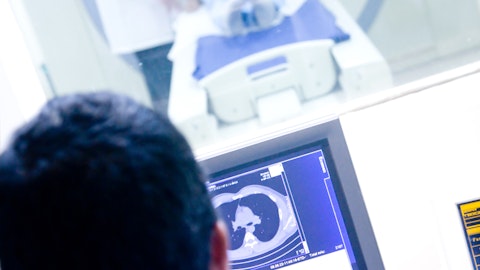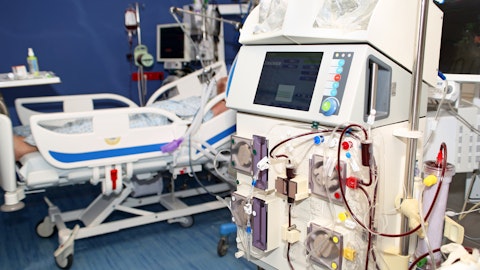GE HealthCare Technologies Inc. (NASDAQ:GEHC) Q3 2023 Earnings Call Transcript November 3, 2023
Operator: Good day and welcome to GE HealthCare’s Third Quarter 2023 Earnings Conference Call. At this time, all participants are in a listen-only mode. Later, we will conduct a question-and-answer session and instructions will be given at that time. As a reminder, this call is being recorded. I would now like to turn the call over to Carolynne Borders, Head of Investor Relations. You may begin.
Carolynne Borders: Thanks, operator. Welcome to GE HealthCare’s Third Quarter 2023 Earnings Call. I’m joined by our President and CEO, Peter Arduini; and our Vice President and CFO, Jay Saccaro. Our conference call remarks will include both GAAP and non-GAAP financial results. Reconciliations between GAAP and non-GAAP measures can be found in today’s press release and in the presentation slides available on our website. During this call, we’ll make forward-looking statements about our performance. These statements are based on how we see things today. As described in our SEC filings, actual results may differ materially due to risks and uncertainties. And with that, I’ll hand the call over to Peter.
Peter Arduini: Thanks, Carolynne. Good morning, everyone, and thanks for joining us today for our third quarter call. To start, I want to say, we’re pleased with our growth, margin and cash flow performance in the quarter. Recently, we’ve launched several new products which I’ll talk about in greater detail later and announced multiple strategic artificial intelligence-based collaborations aimed at supporting new product introductions and clinical applications. We’re honored to have received a grant from the Bill & Melinda Gates Foundation to develop ultrasound tools for less experienced health care professionals and support more effective obstetric and lung ultrasound screening for patients in low and middle-income countries.
We also signed a contract with BARDA, a division of the US Department of Health and Human Services develop advanced ultrasound technology with new AI applications for patients with lung pathologies and traumatic injuries. Both of these combined represent over $80 million of committed funding. Lastly, we announced a strategic collaboration with Mayo Clinic for innovation in medical imaging and theranostics to enhance precision diagnosis and improve patient treatment by using multimodal data, AI and digital health solutions. We’re excited about our recent collaborations and how this will help us deliver on our Precision Care strategy. The business has demonstrated resiliency and our team has executed this year. We’re on track to meet our goals we set at the beginning of the year and we’re making good progress on our mid-range targets.
Despite several macro challenges that occurred in 2023, we have been intensely focused on financial and operational execution to deliver on our commitments. Turning to slide three. We delivered strong third quarter performance with 6% year-over-year organic revenue growth, driven by volume and price. Importantly, book-to-bill in the quarter was 1.03 times, slightly below our book-to-bill of 1.04 times in the second quarter. Customer site rising procedure backlog as a reason for capital investments, particularly for products that we offer. Backlog remains robust at $18.4 billion, driven by Services and Imaging products and remains more than $1 billion higher than pre-COVID levels, which gives us confidence in future quarters. Orders growth was 1% versus the same period last year.
We recently completed a customer pulse survey in the US and see no significant change in sentiment on capital spending in the second half of 2023 versus the first half of the year. Orders growth can be lumpy in any given quarter and results do not directly translate to near-term revenue growth. And this is why we give book-to-bill metric as well as total backlog. As it relates to China and the anticorruption campaign, we saw a limited impact to our orders and revenue in the quarter. Both measures were up year-over-year. We continue to expect a limited impact in the fourth quarter. Also, as a reminder, fourth quarter 2022 orders experienced significant growth due to the China stimulus launch last year, which will influence the year-over-year comparisons next quarter.
China continues to be an important market with a promising growth profile. During the quarter, we continued to make steady progress on our productivity initiatives and business optimization using lean. For example, delivery performance has improved over 15%, a direct result of implementing pool methodology. The number of purchase components classified as high risk for availability has reduced by approximately 35% year-to-date and customer lead times have improved by more than 15% versus the prior year. And lastly, customer satisfaction surveys for service have improved approximately 10%, supported by improvement in parts availability and the great efforts by the service team. On the profit line, we generated adjusted EBIT margin expansion, while simultaneously accelerating R&D investment.
This speaks to our execution capabilities as well as our commitment to funding long-term innovation. Turning to capital allocation. We remain committed to executing an optimized strategy with a focus on creating value for shareholders. Our strong free cash flow generation in the third quarter positions us to be flexible in our capital allocation priorities. We aim to deliver a dividend while continuing to evaluate organic and inorganic investments and deleveraging opportunities. Overall, global markets have remained resilient. Our backlog remains healthy and our team continues to execute. As a result, we’re raising the low end of our adjusted 2023 EPS range representing growth of 11% to 14%. Jay will now take you through our financials and business performance.
Jay?
Jay Saccaro: Thanks, Pete. Starting with our financial performance on Slide 4. For the third quarter of 2023, revenues of $4.8 billion increased 5% year-over-year and grew 6% organically. This was driven by increased volume and price. Book-to-bill was healthy at 1.03x. Order dollars remain strong and continue to outpace revenues. On a stand-alone basis, third quarter adjusted EBIT margin was 15.4%. Sequentially, margin improved 60 basis points benefiting from increased volume and productivity actions. Year-over-year, we generated 120 basis points of margin expansion through productivity initiatives and price, partially offset by planned investments and inflation. I’ll elaborate on the actions we’re taking to expand our margin shortly.
Adjusted EPS was $0.99, down 18% versus prior year due to interest expense, but up 14% on a stand-alone basis driven by increased volume. Free cash flow was up year-over-year due to our strong performance and inventory management. Moving to Slide 5. Revenues grew 6% organically year-over-year. On a reported basis, product revenue increased 6% year-over-year and service revenue grew 5%. We saw strong organic revenue growth across all regions. As it relates to margin performance please turn to Slide 6. Our adjusted gross margin of 41% in the third quarter was strong driven by pricing and enhanced execution by our commercial teams as well as variable cost productivity initiatives that we’re driving. For example, in services productivity, we see lower logistics costs for parts and improved operational rigor.
We also benefited from improving volumes and higher-margin new product introductions. We’re optimizing our G&A spend by rationalizing our real estate footprint and also simplifying our IT services and systems across the businesses to create efficiencies as we scale. We’ve also exited 130 transition service agreements to date. We expect some of the larger scale actions to have a greater impact on results in 2024 and beyond. We’ve made good progress and remain on track to deliver on our 2023 adjusted EBIT margin expansion guidance. This is primarily driven by gross margin expansion, as we continue to invest in R&D which was approximately 7% of revenues in the quarter. Now let’s discuss our segments. Turning to imaging on Slide 7. We generated organic revenue growth of 5% versus the same period last year.
This follows several quarters of strong year-over-year revenue growth reflecting solid backlog and improved fulfillment in price. Revenue growth in the third quarter was driven by MI, CT and MR. This included growth from several new product introductions aimed at driving improved patient outcomes and increased efficiency. Segment EBIT margin improved 150 basis points year-over-year as we made progress in driving productivity price and delivering higher volume all of this more than offset planned investments. Importantly, EBIT margin also improved 150 basis points on a sequential basis. As previously noted, we expected that it would take a few quarters before pricing measures would catch up to inflation headwinds and we’re now seeing that happen.

Turning to Ultrasound on Slide 8. Organic revenue was down 1% year-over-year as we faced a challenging comparison versus the third quarter of 2022, when we delivered double-digit organic revenue growth. Recall, that the third quarter last year was the first quarter in which we started to realize improvements in our access to components for this business. Looking at the two-year average Ultrasound revenue grew in the mid-single digits. The market is stabilizing following COVID and supply chain challenges. We’re continuing to execute and maintain our global leadership position. During the quarter we saw solid demand for newly launched products, in our Women’s Health and Cardiovascular businesses. Segment EBIT margin of 22% was down 360 basis points year-over-year, primarily due to planned investments including cash and health and inflation.
These were partially offset by productivity improvements. Our margin performance reflects our commitment to both organic and inorganic investment as well as technology leadership through AI integration, as we seek to enhance precision diagnostics. In the US, our venue point-of-care product portfolio now features AI for cardiac exams. This AI Guidance Technology provides real-time step-by-step guidance, to allow even new users to capture diagnostic-quality cardiac images. We closed the Caption Health acquisition in February, within six months we incorporated this technology into our portfolio and we’re evaluating other Ultrasound use cases to drive future growth. Moving to Patient Care Solutions on Slide 9. Organic revenue was up 9% driven by volume and price, as we were able to fulfill more backlogs.
Revenue improved as we continue to realize the benefits of supply chain-related actions taken over the past year. Performance was also driven by contribution from NPIs. PCS margin increased 120 basis points compared to the third quarter last year driven by productivity volume growth and price, partially offset by planned investments and inflation. Investments support our monitoring portfolio transformation which enables broader metrics and device interoperability. We’re excited about the new monitoring products that we recently launched and their impact over the next few quarters. Finally, moving to Pharmaceutical Diagnostics on Slide 10, we had another strong quarter generating 12% year-over-year organic revenue growth. Segment EBIT margin of 28.2% improved 140 basis points sequentially, but declined 230 basis points year-over-year due to raw material inflation and planned investments.
This was partially offset by price and productivity actions and volume. We’ve seen PDx EBIT margin stabilized and we’re encouraged by the strong continued growth of global imaging procedures which drive the need for contrast agents. Turning to Slide 11, I’ll walk through our cash flow performance. We delivered strong results this quarter with free cash flow of $570 million, up $22 million year-over-year. This was driven by better inventory management while absorbing interest and post-retirement benefit payments. Inventory improved versus the prior year period, as we continue to leverage lean and solidify our inventory daily management system. We’re also realizing benefits from easing supply chain constraints and inflationary pressure. We saw solid results in controlling inputs while driving inventory turns for faster revenue conversion through lean events and activities organized across the business.
I’m pleased with the fast progress addressing our legacy liabilities and cost structure. In fact, in the past quarter, we were able to achieve agreement to freeze our largest U.S. pension plan conserving cash that can now be allocated to fund investments to grow our business. The solid cash flow profile of our business positions us well for continued investment and deleveraging and we remain on track to deliver free cash flow conversion of 85% or more for the full year. Now, let’s turn to the outlook on Slide 12. We continue to expect organic revenue growth in the range of 6% to 8%. As a reminder, our fourth quarter organic revenue growth will be compared against a very strong performance of 13% growth in the fourth quarter of 2022. We continue to expect full year adjusted EBIT margin in the range of 15.0% to 15.5% and the adjusted effective tax rate in the range of 23% to 25% for the full year.
And given the strong performance to-date, we’re now raising the low end of our full year 2023 adjusted EPS range to $3.75 to $3.85 versus the prior range of $3.70 to $3.85 per share. With that, I’ll hand the call back to Pete.
Peter Arduini: Thanks Jay. Next on slide 13. I want to touch on a few exciting areas where GE HealthCare is investing to advance our precision care strategy. In Imaging, we continue to make progress on the development of our photon counting CT technology. We’ve added Stanford Medicine as a research partner to scan human subjects on our photon counting CT prototype with deep silicone detectors. This innovation aims to enhance imaging capabilities and provide clinicians the information and data they need to improve patient outcomes across many care pathways. Photon counting CT technology with deep Silicon unique to GE HealthCare has the potential to go well beyond the capabilities of traditional CT, and we look forward to continuing to gather data and incorporate feedback that will move our program forward.
In Ultrasound, we recently announced a collaboration with Novo Nordisk to advance the clinical and product development of peripheral focused ultrasound. This marks our introduction into therapeutic ultrasound exploring non-invasive, non-pharmacological methods to treat chronic diseases such as type 2 diabetes and obesity. Encouraging preclinical and early clinical data indicate potential use for people with type 2 diabetes. We are incredibly excited about the potential for this novel technology and its impact on improving patient care. In PDx, we recently made some exciting announcements to advance our delivery of precision care. For example, we signed a licensing agreement with SOFIE Biosciences for Phase 2 diagnostic tracers. The development of FAPI diagnostic targeted agents holds great potential for oncology and other conditions including inflammation fibrosis and arthritis by enabling detection of small primary or metastatic lesions.
Finally, for the second year in a row, we topped the FDA’s list with the most artificial intelligence-enabled device authorizations of any med tech company with 58. Through focused R&D spend we’re committed to bringing high-growth innovative technologies to our customers to improve the way healthcare is delivered. These innovations will create differentiating value for GE HealthCare. Turning to slide 14. We recently centralized our Care Pathway strategy under our Chief Technology Officer. To us, leading our efforts to ensure that we are connecting our products across modalities for each disease state, enabled by our digital solutions. On our last earnings call, I touched on this topic of Alzheimer’s disease. Today, I’ll discuss cardiology as an example, specifically A-Fib to articulate how our solutions comprehensively address this condition.
A-Fib as many of you may know is the most common arrhythmia diagnosed in clinical practice, affecting millions of people worldwide. It’s often misdiagnosed or not treated appropriately with up to 30% of cases missed in routine clinical exams. To advance our A-Fib care pathway, we recently launched CardioVisio, which integrates, organizes and visualizes longitudinal patient data from multiple devices. Taking this data along with current guidelines from the American College of Cardiology, we were able to provide evidence-based clinical decision support from detection through monitoring. CardioVisio connects and presents the most relevant patient data from across the care pathway. And this helps to save time and identify more patients eligible for recommended therapies.
This launch is an important step on our journey to integrate devices and digital solutions to assist cardiologists and caring for patients across the entire cardiovascular care pathway. In the future, we plan to expand CardioVisio to address additional areas such as, coronary artery disease and structural heart. We also expect to launch similar innovations to support oncology and neurology by linking multi-vendor devices, digital and disease-based solutions to better serve our customers and drive growth. Turning to Slide 15. In summary, we’ve made substantial financial and operational progress year-to-date, demonstrating that our strategy is working. Our team continues to execute and I’d like to thank all of our employees across the world for their dedication and efforts.
Before taking your questions, I want to highlight the recent release of our first sustainability report since becoming an independent company. Corporate responsibility is core to our vision, and it embodies our purpose to create a world where health care has no limits. To learn more about our sustainability goals and future plans, visit our ESG page on our website. With that, let’s open up our call to questions.
Carolynne Borders: Thank you, Peter. I’d like to ask participants to limit themselves to one question and one follow-up. Operator, can you please open the line?
See also 14 Best Cyclical Stocks To Invest In and 15 Countries with the Highest Number of Military Satellites in Orbit.
Q&A Session
Follow Ge Healthcare Technologies Inc.
Follow Ge Healthcare Technologies Inc.
Operator: [Operator Instructions] Our first question comes from Vijay Kumar with Evercore. Your line is open.
Q – Vijay Kumar: Hi, guys. Congrats on a good — Good morning, Peter. Congratulations and good execution here. And thanks for taking my question. I did want to touch upon your order commentary here. What was that China in the quarter? And can you quantify, what the order growth was for your capital book of business? And if you can have those numbers ex China, I think there’s some debate on how big of a deal is China to order.
Peter Arduini: Yes, Vijay, let me — I’ll start at a high level and then see Jay wants to add some comments. I’d just start by saying, that we’re continuing to see solid end market demand really around the world including China and I’ll talk about that a little bit more specifically Again, if you step back you’ll recall that in 2021 2022, as customers all of us were coming out of COVID, we saw really strong demand in different products from an orders growth standpoint. Ventilators obviously, but CT ultrasound, monitoring for continuous monitoring. And then that was followed by 2023 this year, which is essentially a transition year with tougher comparisons. But that’s what we planned for. And so as we look ahead here really going even into 2024, we’re expecting that to be kind of the first year with more of a normalized market environment since COVID, which we obviously view as very positive.
So relative to Q3, it’s been as kind of printed market I would say, is how we’ve seen things. If you switch over to your point on China, I’d say, we saw a limited impact to orders and sales in Q3. As I mentioned in the comments here, we were actually up in orders and sales over 2022 in Q3 and we expect limited impact in Q4. So it’s good results overall there. And I’m just proud of eHow and our team in China really did a really nice job and worked through some tough challenges as you can imagine. We’re starting to see signs of the anticorruption campaign stabilize here. We started to — in late September. I think a lot of market events in early August were kind of stopped, but then resumed by October. There was a recent anesthesia congress, that all reports was back to full capacity whereas certain meetings early were low.
So, we believe that we’re going to see a similar kind of trend here continue on in the fourth quarter.
Q – Vijay Kumar: Understood. And I had one follow-up here on margins perhaps, both for you and Jay. I think clearly you mentioned products like CardioVisio, AI solutions. How do you price these solutions? And what’s the margin profile for these kinds of products and related to margins, I think you mentioned price caught up with inflation. Is that something we should be expecting to sustain into fiscal 2024? Thank you.
Peter Arduini: Yes, Vijay, maybe I’ll start and then Jay, you can talk a little bit more about price. So we’re still early innings on the AI monetization but it’s super exciting. Obviously, we’re humbled to be in one of the leadership roles to have new applications out. But the way we think about the start is, AI inside our products which is really across our portfolio now, as those products come out they will bring in some cases 3 4 5-plus points of margin accretion, on a given product to enable that. I think our example that we talk about is an MR where an MR system that has AIR Recon DL and it has quite a bit of step-up of margin over one that doesn’t. And so that’s going to continue to grow. As we bring something like CardioVisio in which you mentioned which again we’re just beginning to roll out as kind of a core offering that will go across many products and will incorporate AI over time that will be a SaaS model where it will be a reoccurring revenue model.
I would say, we will price it based on value structure. And from a margin standpoint, we would expect that to have typical software margins something north of 75%, 80% in that range. And so this is going to be a couple year evolution as we grow this. But this again we believe is the future of multimodal data and really adding value to help solve customers’ issues. So Jay maybe you want to comment about price.
Jay Saccaro: Sure. Vijay, we previously discussed expecting price impacts on sales this year in the 2% to 3% range. And then over the midterm plan that we’ve laid out continuing to see 1% to 2% price. And a lot of that is about the execution framework we have in place a culture around disciplined in pricing. And all of those ingredients are intact. So I would say we’re very much on track for the 2% to 3% this year and we see signs that support the longer-term execution pathway that we previously laid out.
Vijay Kumar: Thanks. Thanks, guys.
Operator: Thank you. Our next question comes from Joanne Wuensch with Citi. Your line is open.
Joanne Wuensch: Good morning and thank you for taking the question. This is the time of the year we start looking forward. And I’m curious about a couple of things. In any particular order how you’re feeling about 2024 street revenue consensus or mid single-digits? And is there anything about the order book year-to-date that would imply or give implications for 2024 that you can share now?
Jay Saccaro: Hi, Joanne thanks for the question. The — we’re going to — we’ll stop short of giving guidance at this point but I would say that — I would say a few things that can provide some color. First, really pleased with the execution so far this year. I think our continued focus on orders execution our continued focus on sales execution and margin enhancement really do set the stage for successful delivery of 2024 and beyond. Secondly, I would point to the backlog that we have in place. The backlog from Q2 to Q3 was essentially flat despite 6% revenue growth. And a lot of that comes down to a book-to-bill that’s continued to be in excess of one. And so we’re really happy with the backlog that’s set up for 2024. The final thing I would say is we do regularly survey customers.
Pete alluded to some of this. And we’re seeing a decent backdrop set up for 2024. I think all of these elements are key ingredients and successfully delivering 2024. And so we’re very focused on that as we go through our planning process in the coming weeks and months. Pete anything to add?
Peter Arduini: No, I think you covered it. I think the point about the customer feedback is really the most important part. I mean, Jay and myself obviously our old teams get out quite a bit around the world. And talk one-on-one with CEOs and leaders of health systems. And again both the commentary as well as our surveys that we do routinely kind of lean to the fact that second half compared to first half is very consistent on market and capital outlook. We’re not a company that’s typically driven by procedures but obviously the procedures drive our business and that continues to be strong. And then I would say we’re hearing more and more incremental positive views about 2024 from customers. You’ve seen prints recently from some customers but also just from a standpoint of with their aging installed base and the procedural growth many customers are thinking ahead about their needs in future.
And obviously, we see this as a healthy outlook. So we’re optimistic about how we see making the turn into 2024.




